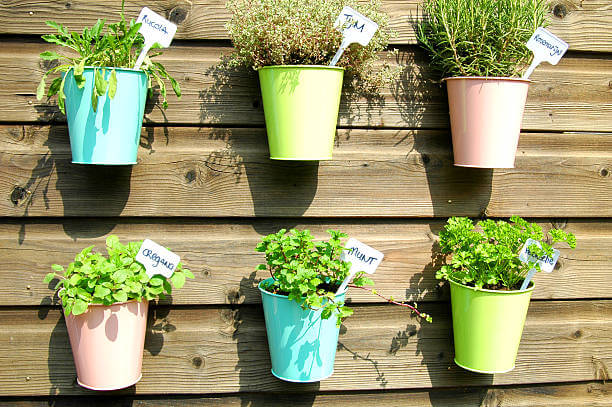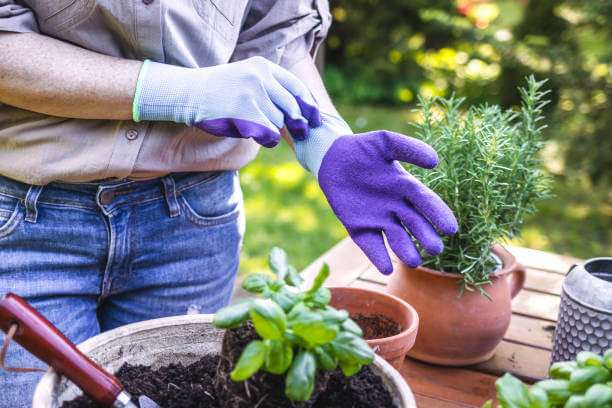- Introduction
- The Top 12 Medicinal Plants You'll Need in Your Medicinal Herb Garden
- Medicinal Herbs Summary Table
- Garden Design and Layout
- Tools for Your Medicinal Herb Garden
- Planting Your Medicinal Herb Garden
- Caring for Your Medicinal Herb Garden
- Harvesting and Preserving Medicinal Herbs
- Conclusion
- FAQ Section
In today’s fast-paced world, more people are turning to natural remedies to maintain their health and well-being. Medicinal herb gardens have gained popularity as individuals seek to harness the healing power of nature.
Whether you’re an experienced gardener or a newcomer with a passion for greenery, this extensive guide will walk you through the process of creating and nurturing your very own medicinal herb garden.
By the end of this article, you’ll be equipped with the knowledge and confidence to cultivate and harvest herbal remedies right in your own backyard.
Introduction
Why Grow a Medicinal Herb Garden?
There’s a certain magic in tending to a garden, and when that garden is filled with medicinal herbs, it becomes a treasure trove of natural healing. Growing your own medicinal herb garden, allows you to take charge of your health in a sustainable and eco-friendly way.
You’ll have access to fresh, potent herbs whenever you need them, and you’ll reduce your reliance on store-bought medicines.

Benefits of Medicinal Herbs
Medicinal herbs offer a wide range of benefits. They can alleviate common ailments, boost your immune system, and promote overall well-being. Here are some key advantages of cultivating a medicinal herb garden:
- Cost-Effective: Growing your own herbs is more economical than buying them, especially if you use herbs frequently for health purposes.
- Freshness: Freshly harvested herbs are more potent and flavorful than dried ones, making them more effective in herbal remedies.
- Control: You have control over the quality of the herbs, ensuring they are free from pesticides and chemicals.
- Sustainability: Cultivating medicinal herbs at home reduces the environmental impact of herb production and transportation.
Now that you understand the benefits, let’s delve into the steps to start your medicinal herb garden.
The Top 12 Medicinal Plants You’ll Need in Your Medicinal Herb Garden
Choosing the Ideal Herbs

When it comes to creating a diverse and potent medicinal herb garden & before you start digging, consider which herbs you want to grow. Research the herbs that best suit your climate and health needs. Here’s a list of popular medicinal herbs to get you started:
- Calendula (Calendula officinalis):
- Medicinal Properties: Calendula is renowned for its anti-inflammatory and skin-healing properties. It’s often used to treat skin irritations, wounds, and rashes.
- Culinary Uses: While not typically consumed as food, its bright orange petals can be used to garnish salads and add color to dishes. It’s mainly prized for its medicinal applications, including soothing salves and skin creams.
- Chamomile (Matricaria chamomilla):
- Medicinal Properties: Chamomile is a well-known digestive aid and a natural relaxant. It’s used to alleviate digestive discomfort, reduce stress, and promote better sleep.
- Culinary Uses: Chamomile flowers are dried and brewed into a soothing herbal tea, enjoyed for its calming effects and delicate, apple-like flavor. It’s also used in aromatherapy for its calming aroma.
- Echinacea (Echinacea purpurea):
- Medicinal Properties: Echinacea is a potent immune system booster, often used to reduce the severity and duration of colds and flu. It stimulates the body’s defense mechanisms.
- Culinary Uses: Echinacea is primarily grown for its medicinal properties and is not commonly used in cooking.
- Lavender (Lavandula angustifolia):
- Medicinal Properties: Lavender is well-known for its stress-relief and sleep-inducing properties. It’s also an excellent topical treatment for minor burns and insect bites.
- Culinary Uses: Lavender flowers can be used to infuse culinary dishes, teas, and desserts with a delightful floral flavor. It’s a popular ingredient in French and Mediterranean cuisine.
- Lemon Balm (Melissa officinalis):
- Medicinal Properties: Lemon balm is prized for its anxiety relief and mild sedative effects. It’s used to alleviate stress, and anxiety, and promote better sleep.
- Culinary Uses: Lemon balm leaves are used to flavor teas, desserts, and salads. It adds a pleasant lemony aroma and taste to dishes.
- Lemon Mint (Monarda citriodora):
- Medicinal Properties: Lemon mint, or lemon bee balm, is a digestive aid and congestion reliever. It’s used to soothe upset stomachs and clear nasal passages.
- Culinary Uses: Its leaves can be used to make refreshing herbal teas, garnish salads, or blend into herbal mixes for added flavor.
- Peppermint (Mentha x piperita):
- Medicinal Properties: Peppermint is renowned for its digestive benefits, relieving indigestion, gas, and nausea. It’s also used to alleviate headaches and congestion.
- Culinary Uses: Peppermint leaves are used to brew teas, flavor desserts, and enhance the aroma of various culinary creations.
- Rosemary (Rosmarinus officinalis):
- Medicinal Properties: Rosemary is known for enhancing memory and concentration. It’s also an antioxidant, helping to combat oxidative stress.
- Culinary Uses: Rosemary is a versatile culinary herb used to flavor meats, roasts, marinades, and even bread. Its aromatic leaves enhance the flavor of many dishes.
- Sage (Salvia officinalis):
- Medicinal Properties: Sage has antibacterial and anti-inflammatory properties. It’s often used to soothe sore throats and enhance cognitive function.
- Culinary Uses: Sage leaves are a popular culinary spice, used in stuffings, sauces, and as a seasoning for poultry and pork. It imparts a savory, earthy flavor.
- Stevia (Stevia rebaudiana):
- Medicinal Properties: Stevia is a natural sweetener that can help regulate blood sugar levels. It’s an excellent sugar substitute for those with diabetes or those looking to reduce sugar intake.
- Culinary Uses: Stevia leaves are used to sweeten beverages and desserts without the added calories of sugar. It’s a popular choice for individuals with dietary restrictions.
- Thyme (Thymus vulgaris):
- Medicinal Properties: Thyme is a powerful antimicrobial herb, used to treat respiratory infections and support overall wellness. It’s also an antioxidant.
- Culinary Uses: Thyme is a classic culinary spice, enhancing the flavor of soups, stews, roasts, and various Mediterranean dishes.
- Valerian (Valeriana officinalis):
- Medicinal Properties: Valerian is a potent natural remedy for insomnia and anxiety. It’s known for its sedative properties, promoting restful sleep.
- Culinary Uses: Valerian is primarily grown for its medicinal properties and is not used in culinary applications.
Medicinal Herbs Summary Table
Here’s a summarized table of the 12 essential medicinal herbs for your garden:
| Herb | Scientific Name | Medicinal Properties | Culinary Uses |
|---|---|---|---|
| Calendula | Calendula officinalis | Anti-inflammatory, skin healing | Edible petals, salads, teas |
| Chamomile | Matricaria chamomilla | Digestive aid, relaxation | Herbal tea, aromatherapy |
| Echinacea | Echinacea purpurea | Immune support | Not typically used in cooking |
| Lavender | Lavandula angustifolia | Stress relief, sleep aid | Culinary spice, teas, oils |
| Lemon Balm | Melissa officinalis | Anxiety relief, sleep aid | Teas, desserts, salads |
| Lemon Mint | Monarda citriodora | Digestive aid, congestion relief | Teas, garnish, herbal blends |
| Peppermint | Mentha x piperita | Digestive aid, headache relief | Teas, desserts, aromatherapy |
| Rosemary | Rosmarinus officinalis | Memory booster, antioxidant | Culinary spice, roasts, marinades |
| Sage | Salvia officinalis | Antibacterial, sore throat relief | Culinary spice, stuffings, teas |
| Stevia | Stevia rebaudiana | Natural sweetener, blood sugar | Culinary spices, stuffings, teas |
| Thyme | Thymus vulgaris | Antimicrobial, respiratory aid | Culinary spice, soups, stews |
| Valerian | Valeriana officinalis | Insomnia relief, anxiety | Herbal teas, tinctures |
These 12 medicinal plants will not only enhance your garden’s beauty but also provide you with a natural pharmacy right at your fingertips. Whether you’re looking to soothe ailments or add unique flavors to your culinary creations, these herbs are invaluable additions to your medicinal herb garden.
Our Best Recommendation For Your Medicinal Herb Garden
Garden Design and Layout
Selecting the Right Location
Choosing the right location is paramount to the success of your medicinal herb garden. Most herbs thrive in sunny locations, so look for a spot that receives at least 6-8 hours of direct sunlight per day. Ensure good drainage to prevent waterlogged soil, which can lead to root rot.
Raised Beds vs. Traditional Gardens
You have the option to create a traditional in-ground garden or use raised beds. Raised beds offer better drainage, weed control, and easier access for maintenance. If you have poor soil quality, raised beds can be a great solution.
Companion Planting
Incorporate companion plants to boost the health and vitality of your medicinal herbs. For instance, planting marigolds alongside your herbs can deter aphids, while basil can enhance the flavor and growth of nearby herbs like tomatoes.
Soil Preparation
Prepare the soil by adding organic matter, such as compost or well-rotted manure, to improve fertility and drainage. Perform a soil test to determine the pH level and make any necessary adjustments. Most herbs prefer slightly acidic to neutral soil (pH 6-7).
Tools for Your Medicinal Herb Garden

Before you roll up your sleeves and start planting your medicinal herb garden, it’s essential to have the right tools at your disposal. These tools will make the process more efficient and enjoyable. Here’s a list of essential gardening tools you’ll need:
- Garden Gloves: Protect your hands from dirt, thorns, and any irritants you might encounter while tending to your herbs.
- Hand Trowel: This small, handheld tool is perfect for digging small holes for planting herbs and transplanting seedlings.
- Pruning Shears: Pruning shears or secateurs are crucial for trimming and shaping your herb plants as they grow.
- Garden Fork: A garden fork is useful for turning and aerating the soil, ensuring proper root growth.
- Rake: Use a rake to level the soil and remove debris and leaves from your garden bed.
- Hose or Watering Can: A hose with an adjustable nozzle or a watering can will help you provide your herbs with the right amount of water.
- Garden Spade: This tool comes in handy for digging larger holes, edging your garden bed, and mixing soil amendments.
- Mulch: While not a tool, mulch is essential for retaining soil moisture, suppressing weeds, and regulating soil temperature.
- Garden Pruner: For thicker branches and stems, a garden pruner is more suitable than pruning shears.
- Garden Kneeler: A garden kneeler with cushioning can make your gardening sessions more comfortable and reduce strain on your knees and back.
Having these tools on hand will ensure that you can effectively care for your medicinal herb garden and keep it thriving throughout the seasons.
Planting Your Medicinal Herb Garden

Starting from Seeds
Starting herbs from seeds can be a cost-effective way to grow a wide variety of plants. Selecting the best medicinal herb seeds is a crucial step in establishing a thriving medicinal herb garden. To make the right choices, consider several factors.
First, evaluate your local climate and growing conditions to ensure the herbs you choose are well-suited to your region. Research each herb’s specific requirements for sunlight, soil type, and moisture levels.
It’s also essential to prioritize herbs that align with your health and wellness goals, as different herbs offer various medicinal benefits.
Pay attention to the quality of the seeds; opt for reputable seed suppliers or nurseries to ensure you’re getting viable, disease-free seeds. Lastly, think about the space available in your garden, as some herbs may spread rapidly or require more room to grow.
By carefully considering these factors, you can handpick the best medicinal herb seeds for your garden, setting the foundation for a thriving and beneficial herbal haven.
Transplanting Seedlings
If you prefer a head start, you can purchase herb seedlings from a nursery or garden center. When transplanting, be gentle with the young plants to avoid damaging the roots. Plant them at the same depth they were in their original containers.
Propagating Herbs
Many herbs can be propagated from cuttings or divisions. This allows you to create new plants from existing ones. For example, mint can be propagated by taking stem cuttings and placing them in water until they develop roots.
Caring for Your Medicinal Herb Garden
Watering and Irrigation
Herbs generally prefer evenly moist soil. Water them at the base to avoid wetting the leaves, which can lead to disease. Use a drip irrigation system or a soaker hose for efficient watering.
Fertilization
Fertilize your herbs sparingly. Excess fertilizer can lead to excessive growth and dilute the potency of the herbs. Use a balanced, organic fertilizer and apply it according to the manufacturer’s instructions.
Pest and Disease Management
Keep a watchful eye for common pests like aphids, snails, and spider mites. Identify and address pest issues promptly, using natural remedies or insecticidal soaps to avoid harsh chemicals. Prevent fungal diseases by providing good air circulation and avoiding overwatering.
Harvesting and Preserving Medicinal Herbs
Timing Your Harvest
The best time to harvest medicinal herbs is in the morning when the essential oils are most concentrated. Harvest just before the plants bloom for optimal potency. Use clean, sharp scissors or pruning shears to avoid damaging the plants.
Drying and Storing Herbs
To preserve your herbs, dry them properly. Hang bundles of herbs upside down in a dry, dark place with good airflow. Once dried, store them in airtight containers in a cool, dark pantry. Label containers with the herb’s name and harvest date for easy identification.
Making Herbal Remedies
With your freshly harvested herbs, you can create a variety of herbal remedies, including teas, tinctures, salves, and infused oils. Experiment with different recipes and consult reputable herbal books or experts for guidance.
Conclusion
By now, you’ve learned the ins and outs of starting your very own medicinal herb garden. From selecting the right location to harvesting and preserving your herbs, you’re well-prepared to embark on this rewarding journey.
Your garden will not only provide you with fresh, potent herbs but also a deeper connection to the natural world and the power of herbal medicine.
So, roll up your sleeves, grab your gardening tools, and let the healing garden adventure begin
FAQ Section
How do I choose the best herbs for my garden?
Select herbs that thrive in your climate and suit your health needs. Consider your garden’s sunlight, soil type, and available space when choosing herbs.
What is the best time to harvest medicinal herbs?
The best time to harvest is usually in the morning just before flowering. This is when the herbs’ essential oils are most concentrated.
Can I grow medicinal herbs indoors?
Yes, many medicinal herbs can be grown indoors in containers. Provide them with adequate light and proper care to thrive.
How do I make herbal teas and tinctures?
To make herbal teas, steep fresh or dried herbs in hot water. For tinctures, soak herbs in alcohol or glycerin to extract their medicinal properties.
What are some common pests and diseases to watch out for?
Common pests include aphids, snails, and spider mites. Watch out for fungal diseases like powdery mildew and root rot. Address issues promptly using natural remedies.
How often should I prune my medicinal herbs?
Pruning frequency depends on the herb and its growth habits. Some herbs benefit from regular pruning to encourage bushier growth, while others require minimal pruning. Observe your plants and prune as needed to maintain their health and shape.
Can I grow medicinal herbs in containers?
Yes, many medicinal herbs can thrive in containers, making them suitable for small spaces or urban gardening. Ensure your containers have good drainage, and choose a well-draining potting mix. Be mindful of the size of the container, as some herbs, like mint, can be quite invasive.
What are some natural pest control methods for my herb garden?
To deter pests naturally, consider planting companion plants that repel common herb garden pests. For example, planting basil alongside tomatoes can deter aphids. Additionally, you can use homemade remedies like neem oil or garlic spray to fend off pests without resorting to chemical pesticides.
How long do dried herbs remain potent?
The potency of dried herbs can vary depending on the herb and how well it’s dried and stored. In general, most dried herbs remain potent for about one year. However, some herbs, like dried bay leaves, can retain their flavor for several years when stored properly in airtight containers.
What are some resources for learning more about herbal medicine?
There are many excellent books, online courses, and herbalists who can provide valuable information on herbal medicine. Consider joining local gardening or herbalist groups to connect with like-minded individuals and gain practical knowledge.




